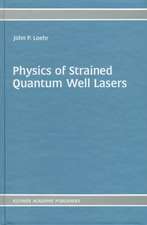Laser Processing and Analysis of Materials
Autor Walter W. Duleyen Limba Engleză Paperback – 14 iun 2012
Preț: 397.38 lei
Nou
Puncte Express: 596
Preț estimativ în valută:
76.04€ • 79.60$ • 62.92£
76.04€ • 79.60$ • 62.92£
Carte tipărită la comandă
Livrare economică 07-21 aprilie
Preluare comenzi: 021 569.72.76
Specificații
ISBN-13: 9781475701951
ISBN-10: 1475701950
Pagini: 480
Ilustrații: XIV, 464 p. 86 illus.
Dimensiuni: 152 x 229 x 25 mm
Greutate: 0.64 kg
Ediția:Softcover reprint of the original 1st ed. 1983
Editura: Springer Us
Colecția Springer
Locul publicării:New York, NY, United States
ISBN-10: 1475701950
Pagini: 480
Ilustrații: XIV, 464 p. 86 illus.
Dimensiuni: 152 x 229 x 25 mm
Greutate: 0.64 kg
Ediția:Softcover reprint of the original 1st ed. 1983
Editura: Springer Us
Colecția Springer
Locul publicării:New York, NY, United States
Public țintă
ResearchCuprins
1 Lasers and Laser Radiation.- 1.1. Introduction.- 1.2. Laser Sources.- 1.3. Laser Radiation.- 1.4. Lens Aberrations.- 1.5. Window Materials.- 1.6. Mirrors and Polarizers.- 1.7. Q-Switching.- 1.8. Frequency Conversion.- 1.9. Mode Locking.- 1.10. Detectors and Power Meters.- 2. Materials Processing.- 2.1. Absorption of Laser Radiation by Metals.- 2.2. Absorption of Laser Radiation by Semiconductors and Insulators.- 2.3. Thermal Constants.- 2.4. Laser Drilling: Heat Transfer.- 2.5. Welding.- 2.6. Cutting.- 2.7. Micromachining.- 2.8. Surface Hardening.- 2.9. Surface Melting, Alloying, and Cladding.- 2.10. Surface Cleaning.- 2.11. Crystal Growth.- 2.12. Optical Fiber Splicing.- 2.13. Laser Deposition of Thin Films.- 3 Laser Processing of Semiconductors.- 3.1. Introduction.- 3.2. Annealing.- 3.3. Annealing—CW Lasers.- 3.4. Recrystallization.- 3.5. Silicide Formation.- 3.6. Ohmic Contacts and Junction Formation.- 3.7. Device Fabrication.- 3.8. Electrical Connections on Integrated Circuits.- 3.9. Monolithic Displays.- 4 Chemical Processing.- 4.1. Introduction.- 4.2. Schemes for Laser Isotope Separation.- 4.3. The Enrichment Factor.- 4.4. Laser-Induced Reaction.- 4.5. Single-Photon Predissociation.- 4.6. Two-Photon Dissociation.- 4.7. Photoisomerization.- 4.8. Two-Step Photoionization.- 4.9. Photodeflection.- 4.10. Multiphoton Dissociation.- 4.11. Selective Raman Excitation.- 4.12. Economics of Laser Isotope Separation.- 4.13. Laser-Induced Reactions.- 4.14. Isomerization.- 4.15. Lasers in Catalysis.- 4.16. Laser-Induced Reactions: UV-VIS Excitation.- 4.17. Processing via Thermal Heating.- 4.18. Polymerization.- 5 Lasers in Chemical Analysis.- 5.1. Introduction.- 5.2. Absorption Spectroscopy.- 5.3. Laser-Induced Fluorescence.- 5.4. Laser-Enhanced Ionization Spectroscopy.-5.5. Multiphoton Ionization.- 5.6. Raman Spectroscopy.- 5.7. Laser Magnetic Resonance.- 5.8. Laser Photoacoustic Spectroscopy.- 5.9. Laser Microprobe.- 5.10. Atomic Absorption Spectrometry.- 5.11. Laser Microprobe Mass Spectrometer.- 5.12. Laser Raman Microprobe.- 5.13. Lasers in Chromatography.- 6 Lasers in Environmental Analysis.- 6.1. Propagation of Laser Radiation through the Atmosphere.- 6.2. Laser Remote Sensing of the Atmosphere.- 6.3. Laser Sampling of Aerosols.- 6.4. Laser Remote Sensing of Water Quality.- References.- Materials Index.























